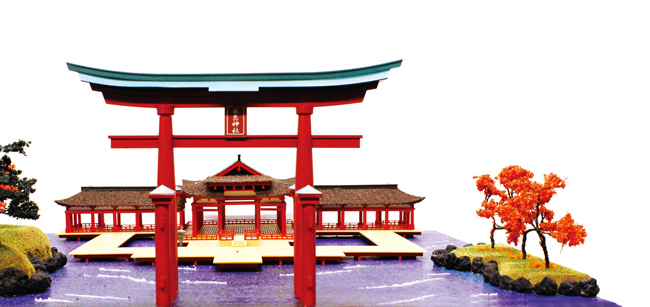
当たり前に日本人として生きてきた。でも海外に出てから、日本について何も知らないことに気が付いた。そこで、日本が世界に誇る世界遺産について建立年順に勉強しようと思う。興味がある人も、そうでない人も、しばしお付き合いを。
I’ve lived my whole life as a Japanese person, but when I went overseas I realised I know practically nothing about Japan. So now I’m learning about Japan’s World Heritage Sites, from oldest to newest. Those who are interested, and even those who are not, come along for the ride.

撮影協力 / メルボルン総領事館 Thanks to the Consulate-General of Japan, Melbourne
○○○○○ 平安の荘厳華麗な姿を伝える日本屈指の名社 厳島神社 ○○○○○
今回から12回にわたり、【日本にある世界の遺産】を紹介していきます。最初に紹介するのは、1996年に世界遺産に登録された厳島(いつくしま)神社。海の真ん中に聳え立つ大鳥居は、実物でなくても、テレビや雑誌などで1度は目にしたことがあるのではないでしょうか。世界遺産として登録されている区域は、社殿を中心とする厳島神社と前面の海、背後の弥山原始林(天然記念物)の森林を含む431.2ヘクタールで、厳島の約14%を占めています。
厳島神社は、広島県廿日市(はつかいち)市宮島町、厳島(通称、宮島)に鎮座する神社で、国宝にも指定されています。ちょっと余談ですが、町名と通称が宮島で、島の正式名称と神社名が厳島なのは、どうして? っと疑問に思った方もいるのではないでしょうか。元々は、厳島で統一されていたのですが、江戸時代以降から『お宮(厳島神社)のある島』という意味で宮島と呼ぶようになり、それが次第に広がっていきました。1950年に、読みやすさや漢字の平易さから町名を厳島町から宮島町に変更するという経緯があり、今に至っています。
話を厳島神社に戻しましょう。創建は、593年に島の有力者であった佐伯 鞍職(さえきのくらもと)によると伝えられています。そして、平安時代中期から後期には、平 清盛(たいらのきよもり)をはじめとする平家一族の庇護のもと、高位貴族の住宅様式であった寝殿造りを模した廻廊で結ばれた社殿を造営、基礎を確立します。現在のような重機もない上、浜地での建設、完成するまでに数年が費やされたのは、言うまでもありません。むしろ、数年で完成したのが凄いですよね。しかし、その後2度の火災に遭い、今の本社本殿は1571年、客神社は1241年に建築されたものです。ところで、なぜ建設が大変な海を敷地に社殿を建てたのか? それは、古くから厳島全体がご神体として崇められため、神聖な土地に建てるのを避けたと言われています。その結果、深い緑に覆われた山容を背景に、海上に鮮やかな朱塗りの本社本殿や大鳥居などの社殿群が展開する、独特な景観を生み出しています。また、厳島には信仰上の理由から、今でも『不浄を避けるため』という意味で島内には墓地がないそうです。
平家の滅亡後は、現在のような形式の大鳥居を領主大内(おおうち)氏が再建、その後は戦国大名の毛利(もうり)氏が天神社の創建、反橋や大鳥居も再建しました。豊臣 秀吉(とよとみ ひでよし)も手厚く信仰し庇護したそうです。今日まで、海水による腐食、自然災害や火災など再建・修復が繰り返し行われてきました。見所の1つでもある高さ16mの大鳥居は、1876年に立てられた8代目で、資材の巨木探しだけでも20年近い歳月を要したそうです。現在は、国や県の補助や寄付金などで修復費が賄われています。また美しい景観を守るため、藻の清掃作業や、砂州の地ならしなど日々細やかな手入れがされています。
潮の干満によって建物の表情が変わり、見る人々に静寂でありながら華やかな印象を与える厳島神社。日本古来からの、自然に神が宿るという信仰を形にした場所でもあります。
次回は、奈良県の法隆寺を紹介します。
○○○ Itsukushima Shrine: A famous shrine with majestic Heian architecture ○○○
This time we begin a twelve-part series on Japan’s World Heritage Sites. The first is Itsukushima Shrine, which was added to the World Heritage list in 1996. You have probably seen its huge red ‘Otorii’ (Grand Shrine Gates) that rise from the ocean, if not in person then as an image. The heritage-listed area centres on the main buildings of Itsukushima Shrine, and also includes the shoreline to the front and the primeval forest of Mount Misen behind. The forest makes up 431.2 hectares of land, or around 14% of the island.
Itsukushima Shrine is a national treasure on the island of Itsukushima (nicknamed Miyajima), which belongs to the town of Miyajima in Hatsukaichi, Hiroshima Prefecture. You might be wondering why the town name and the island’s nickname are Miyajima but the island’s official name and the shrine’s name are Itsukushima. Originally known only as Itsukushima, from the Edo period it came to be known as Miyajima (‘shrine island’). The nickname gradually spread, and in 1950 the town was officially renamed ‘Miyajima’ as the kanji is easier to read and write than that of ‘Itsukushima’.
To return to our topic: Itsukushima Shrine was founded in 593 by Saeki-no-Kuromoto. Then in the mid-to-late Heian period, the main shrine buildings were established under the patronage of the Taira clan. The buildings were joined by covered walkways, in imitation of the architecture of Heian period palaces. Without modern heavy machinery and with construction occurring on the seashore, needless to say it took several years to be completed. Actually, it’s amazing that it was completed in so short a time! However after two fires, the current main shrine was rebuilt in 1571 and the Marodo Shrine (shrine for the guest deity) in 1241. As for why a shrine would be built in such a difficult seaside location, the reason is that from ancient times the entire island of Itsukushima was revered as containing the spirits of gods. By building on the shore, they avoided building on ‘sacred land’. Unique scenery was created as a result: the brilliant vermillion Otorii and shrine buildings spreading out on the seashore against the background of the densely forested mountains.
After the fall of the Taira clan, the Otorii was rebuilt in its current form by the Ouchi clan, and then during the Sengoku period the Mori clan established the Tenjinja shrine and rebuilt the Sori-bashi Bridge, the Otorii, and more. Toyotomi Hideyoshi (a devout believer) was also a patron. Due to corrosion by seawater, natural disasters and fires, rebuilding and repairs have been repeatedly been made up to the present day. For the 16m high Otorii, built for the eighth time in 1876, it took 20 years just to find big enough trees! These days, the prefecture and the state provide assistance and monetary contributions to cover the cost of repairs. Also, to preserve the beautiful scenery, small acts of maintenance (such as the clearing away of seaweed and leveling of sand dunes) are carried out every day.
With its changing appearance in the tide’s ebb and flow, Itsukushima Shrine leaves its visitors with a quiet yet brilliant impression. It is also a place that embodies the ancient Japanese belief that gods dwell in nature.
Next time, I introduce Horyu-ji, a Buddhist temple in Nara Prefecture.

